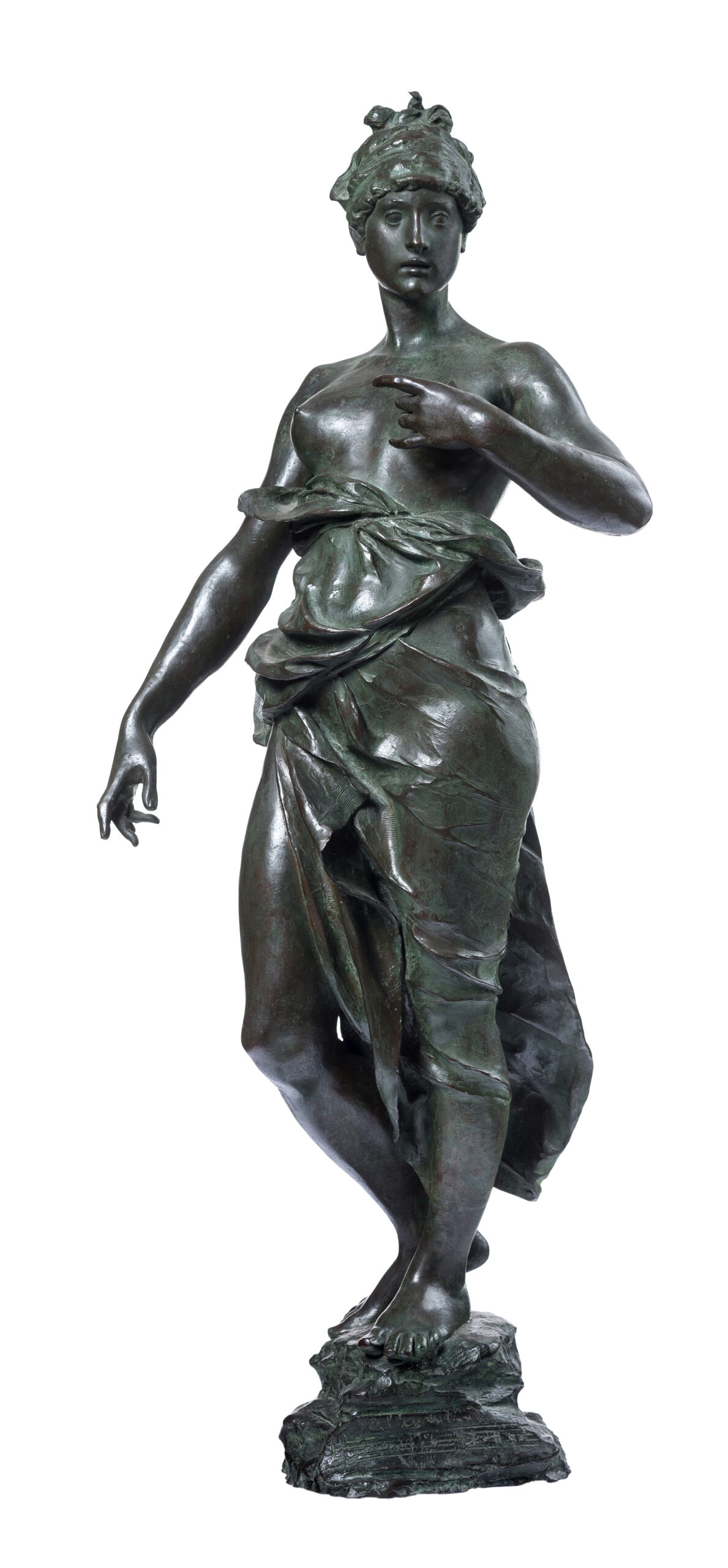Allegreto by Julien Dillens
The bronze sculpture depicts a graceful and triumphant young woman and perfectly represents the realism for which Julien Dillens was known throughout his career.
This green patinated bronze sculpture by Julien Dillens was cast using the lost-wax casting technique by the Compagnie des bronzes de Bruxelles. The sculpture depicts a graceful and triumphant young woman and perfectly represents the realism for which Julien Dillens was known throughout his career. Itis accompanied by its original column made of red marble, gilded bronze and onyx. The column is also decorated with two gilded bronze coats of arms, one representing the Provincial Administration of Brabant, the other the Provincial Clerk, Mr Barbiaux.
Indeed, the sculpture and its column were presented as a gesture of appreciation to Mr. Barbiaux by the Provincial Administration of Brabant on July 12, 1888, in appreciation of service rendered over many years. The sculpture and its column are accompanied by a gold-embossed leather-bound folder. The folder is addressed to Mr. L. Barbiaux, the recipient of the work. It contains the thanks and the signatures of influential persons within the Brabant Administration and is dated 1888.
The sculpture is signed “J Dillens”, identifying it as the work of the Belgian sculptor Julien Dillens.
Julien Dillens, the son of painter Henri Dillens, was born in Anvers in 1849. Julien studied painting at the Brussels Academy from 1861 to 1867 and modelling under Eugène Simonis from 1868 to 1873. He then met Carrier-Belleuse and Rodin while working on projects in the city of Brussels. Dillens exhibited at the Antwerp Salon in 1870 (Bust of a Child) and participated in several fairs in Ghent, Namur and Brussels. He won the first prize in the competition organized by the Compagnie des Bronzes with his work « Le Temps » and then first prize at the Royal Academy with « L’Agriculture» in 1875.
Julien Dillens became well known for his « realism in every aspect » which was very well received. In 1876, a group of artists affiliated with Academies of Fine Arts in Brussels joined Dillens in founding the Belgian artist group « L’Essor » with which Dillens would exhibit his most important sculptures. The same year he won the most prestigious « Prix de Rome » award, which allowed him to travel to France and Italy. Julien Dillens is one of the great Belgian sculptors of the late 19th century. His work was exhibited at all the major exhibitions and he participated in the construction of many monuments:
- The Palace of Laeken, Brussels – decorative relief.
- Museum of Ancient Art, Decorative and Industrial Arts.
- Ghent City Hall.
- Town Hall of Saint-Gilles.
- Saint-Gilles Cemetery.
- Advocate Hippolyte Metdepenningen (1886, Ghent)
- Fountains in Ixelles, Perseus and Andromache.
- Grand Place de Bruxelles.
Dillens‘ influence as an artist extended well beyond the borders of Belgium; he exhibited extensively in cities such as Berlin, Amsterdam, Edinburgh and Krefeld, amongst others. He also became a professor at the Ixelles School of Art and a professor at the Brussels Academy from 1898.
Compagnie des Bronzes de Bruxelles.
1888 : Gift to the Clerk Mr. L. Barbiaux by the Provincial Administration of Brabant.
2005 : Gallery Maurice Tzwern, Brussels.
Height: 85,5 cm.
Width: 19 cm.
Depth: 18,5 cm.
